Thailand Kamlangjai for ReconstructionAugust 2011

This year in August Kazuki Yano (54) living in Bangkok, Thailand was shocked by the Great East Japan Earthquake. He visited the south of Thailand which was hit by the Sumatra Earthquake in 2004 and the resulting tsunami. He visited Thailand, not Tohoku, Japan. The reason was not only the matter of travel expense, but also something else.
Volunteer Life
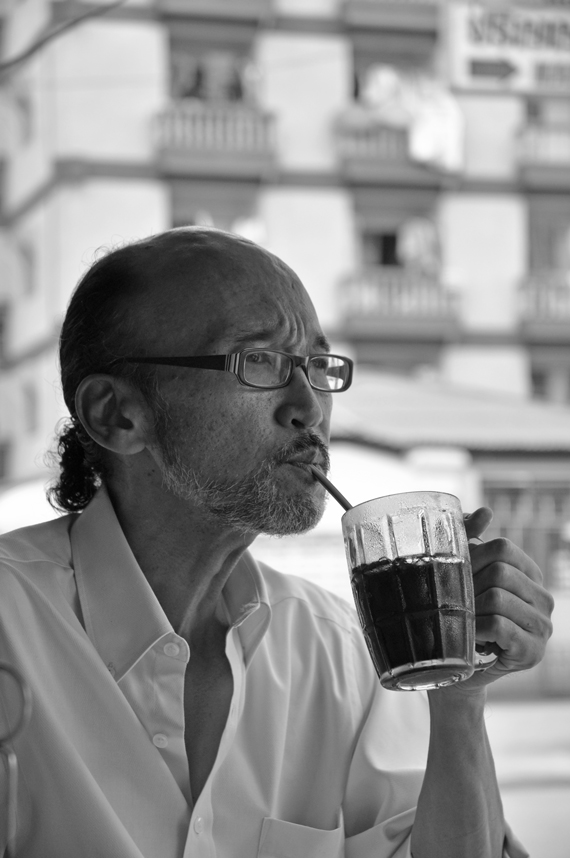
This year in March the devastation of the Sanriku Coast and the damage of the earthquake and the tsunami were broadcasted on Thai TV. This catastrophe made the headlines every day. He wanted to visit the disaster-hit area so bad, but he knew he couldn’t. So he decided to visit the South of Thailand for the first time in six years instead and learn something that might benefit for his country, Japan. Besides, he was worried about the Tsunami Memorial Hall in the disaster-hit area in the 2004 Sumatra Earthquake where he was asked to perform in its opening ceremony. The construction of the Tsunami Memorial Hall was initially expected to be completed in April this year. However, the construction has not even started yet.
At 7:58 a.m. December 26, 2004 a magnitude 9.1 earthquake struck off the Indonesian island of Sumatra. Indonesia was the hardest-hit country. The death toll was approximately 220,000. More than 8,000 became the victims of the resulting tsunami in Thailand. The Thaksin administration had been giving favorable policies to suburban provinces and having strong support from the locals at that time. The administration responded quickly to these dasasters. So did many citizen volunteers. They brought in relief supplies to the disaster areas with trucks. Back to Mr. Yano, at the end of April, 2005, 150 days after the disaster, he gave a free public performance as part of his volunteer work in the South of Thailand. His performance was to console the victims and also to report, “The Disaster-hit Area after 150 Days,” which had not been so much reported to people in Bangkok at that time.
Mr. Yano is in fact a famous Japanese actor in Thailand. In the ’90s he started to have small roles and appear in the movies. After 2005 Thai directors have been asking him to play a role in their movies. He has nominated for the best supporting actor. He is so popular that people ask him to take pictures with him and ask for an autograph when he walks down the street. On the other part of his life, he has been giving a public performance as his volunteer work in physically challenged children schools and group homes for children in Thailand, Myanmar, Laos and Bangladesh. He has been always performing a one-man show with pantomime because unlike the movie there are no language barriers in pantomime.
His volunteer life began when he visited refugee camps in Cambodia for the first time in his fourth year in college. There were people who escaped from the battles and the political repression and finally made it to the camps. What they needed most in the first place was water, food, place to sleep and emergency rescue like first aid in illness and injury. At this point there were a lot of things students could do even though they did not have particular skills and experiences. However, evacuees had to live in refugee camps for over ten years until the United Nations Transitional Authority in Cambodia took over the administration of the state.
After Mr. Yano went back to Japan and graduated from college, he visited refugee camps again as an examiner of refugee resettlement for the Embassy of Japan in Thailand. He conducted screenings (checked eligibility) for refugees who were hoping to be resettled to Japan and were going to take interviews. He wrote a book called, “Pantomime in the Refugee Camps (published by the Mekong Publishing 1992.)” He said in the book that he found what qualities refugees needed to have if they wanted to be accepted in another country and what they needed to have in order to create their own future in resettlement countries. Since the refugees fleed their homes without bringing anything, the assistance for them needed to be not only the emergency aid, but it needed to be continued until they could support themselves either in the resettlement areas or in their hometowns when they could possibly go back. The continued assistance could be providing housing, information on how to manage mental and physical health, language education and vocational training. At that time Mr.Yano wondered what he could do for the refugees even though he was neither a doctor nor a teacher nor an enginner. If you lived in confined spaces with distributed food for several years, not only refugees but anybody would never hold dreams and hopes. Even if he had dreams and hopes, he would be very likely to lose them. So Mr. Yano decided to performe pantomimes which he learned in Japan for people who were in despair and lost their motivations to live. The refugees laughed so hard and some people actually got energy back with his performance. At the same time his concern for what he could do for them had disappeared. And that is what it says in his book.
The Tropical Beach That Does Not Look Like Tragedy Ever Happened Before

More than about one hour by air from Bangkok, there is the Phuket Island which is popular with Japanese tourists. Mr. Yano stopped by at the world-famous Patong Beach and found that the scenery there never looked like it was actually attacked by a tsunami. All the hotels and shops on the street in front of the beach looked the same as before. There were no artificial barriers such as embankments and wave-dissipating blocks. He could find only the horizon between sky and sea. And Under the line of brilliant colored parasols that stretch out for hundreds of meters, tourists spent their time relaxing, getting massages or reading novels.
Mr. Chantra (32) walks and sells T-shirts and traditional costumes on the beach. He said as if it were yesterday, “After the tsunami the number of my customers declined dramatically. But many of them are coming back and probably 70 % of them have come back.” On that day he was selling the same stuff here. When the tide was out and the bottom of the sea appeared after the earthquake, the tourists and the locals were having fun trying to catch fish jumping up and down. Then he saw a huge wave surging over the bridge which was connecting the island and the mainland. It was coming towards him. He immediately ran and headed inland. But many people didn’t notice and didn’t escape. They were still catching fish even though they saw the big wave. Mr. Chantra said, “I did not care about the fish.”
The most damaged area in Thailand was along the coast of Phang-nga province in the northern Phuket Island (province). This is the place Mr. Yano visited 150 days after the disaster. He planned to visit again the Namkem Village where many of the people make their living in the fishing industry or working for rubber plantations and Khao Lak Beach which is a popular tourist spot among wealthy people in Thailand and those westerners who stay away from the vulgarized Phuket.
The Village of Salty Water
“You guys are so lucky. It had been rainning until yesterday for 4 or 5 days straight.” A local taxi driver looked happy and was simply enjoying having us under the blue sky. The Namkem Village is located along the coast and about two and a half hours north of Phuket. There are the Tsunami Memorial Park and the Cemetery for the Tsunami Victims in the village. People say that Namkem means, “salty water.” When you look at the map, you can find the village on the lowlands protruding to the sea. That is the reason why there had been so much accumulation of earth and sand brougut by the river. And because of the long rain, you could see newly made puddles here and there.
He found that a blue steel pole was built to commemorate the tsunami in the Namkem Village Tsunami Memorial Park which was facing the beach. On the pole an inscription both in English and Thai said, “A 5-meter high tsunami on December 26, 2004.” Mr.Yano looked at the inscription and began to talk thinking back of those days. “This ‘Kluern-yak’ means tsunami in Thai. It would be ‘demon wave’ in the literal translation. On that day I happened to be listening to the radio in Bangkok. At first they were saying, ‘Kluern-yak,’ but several hours later almost all the radio stations started to use this Japanese word ‘tsunami’ instead of ‘kluern-yak.’ He visited the park under construction six years ago. There were a long and curved concrete wall in the shape of a wave and a monument facing the wall. The names, the dates of birth, the photos of the victims and the messages from the families of the deceased were burned and engraved on the tiles of the monument. Since it was a popular resort, it was understandable to find so many foreign names of the deceased on the tile. But those people were only small parts of the victims.
In the Cemetery for the Tsunami Victims Mr. Yano was shocked to see so many tombstones. “It’s easy to imagine that there were actually as many dead bodies right in front of you. There are still seven thousand people (then) missing. Well…” The stainless steel nameplates on the concrete tombstones read only some alphabet letters and numbers. No names, sexes, even ages or how they looked like were written. Some of the families thought that there should be their loved ones among these unidentified deceased. The bodies were terribly damaged.
Laughing Hard at His Pantomimes

Mr. Yano decided to perform a pantomime at school in this village. The teacher’s room was an old building, built before the tsunami. But the new gymnasium where Mr. Yano was going to perform and the new classroom building were constructed as part of disaster assistance. Mr. Yano’s props were only a Boston bag, black cloth and a PVC pipe in a golf bag that could hold about three golf clubs. These things all made excellent props. Mr. Yano set up a stage screen with children as usual to make them curious about his pantomime since they have never seen a pantomime.
In his pantomime there is a bag which looks as heavy as it is sticking to the floor. There is a rubber balloon which looks heavy and moves like a creature with some intentions. There is a weightlifting tournament participated by the men and women of all ages and also people with gender identity disorder. He rides a large invisible motorcycle with some kids on the back, making engine sounds only with a whistle. His motorcycle roars through a street. Those kids laughed and held their sides. Their houses had been washed away. They had lost their families, relatives and some of their friends. “I can never quit performing for them because they laugh so hard even though my pantomime technique is not so good.” Mr. Yano has been living a simple life with the money he earned as an actor. The rest of the money is used for these volunteer performances. Such audience reaction has become his driving force for performance more than anything. However, if he performs in the countryside, he cannot use his elevator and escalator pieces just because there are no tall buildings in the area and most of the children have never been on them.
Ms. Nusara (14) rode Mr. Yano’s invisible motorcycle with him. She said, “This is my first time to see a pantomime. It made us all happy.” She was wearing light makeup in her school uniform since she knew she would see a movie star form Bangkok. “It was fun and it took away stress,” said Ms. Klinkamon of the same age as Ms. Nusara. Mr. Yano heard and got to know what they really needed for revitalization. That is what he really wanted to find out. Ms. Klinkamon said, “It was ‘Kamlangjai (=Hope.)'” Ms. Nusara said, “We came this far, not losing to what has happened to us because some people encouraged us and gave us ‘hope’ when we were so discouraged. When we were under lots of stress and depression, they always gave us some words of encouragement. That’s why our negative ideas gradually disappeared.” When they were asked what they needed for their revitalization, they never mentioned things like a classroom, a text book or a school uniform. They said unanimously that it was Kamlangjai (=Hope) that they really needed.
This time, Mr. Yano visited one more school. That was Rajaprajanugroh School 35. It was newly established on the hill with the aid of the King four months after the tsunami. In the thick grass under the hill, there remained only the foundation and the gateposts of the old school. About 750 students from kindergarten through high school studied there and 80% of them were living in the dormitory on the premises. When the school was opened, 30% of the students had lost their parents in the tsunami. Many students live in the dormitory because their schools on the coast were washed away and their villages were too far to commute to this Rachapacha School. Some boys who were Mr. Yano’s fans and want to be comedians in the future took him to the dorm to show him around. Mr. Yano said, “I think it is great that the students here live all together dispite such age difference. You would almost never see that in Japan.” In the dorm the students came up to him one after another. They asked him for autographs and asked him to take pictures with them. Mr. Yano understood that all the students were looking forward to his pantomime. He decided to perform three times with a 30 minute break between each performance so that everybody could see.
Just like Namkem School there were convulsions of laughter here again. Although it might have happened only during his perfomance, the students had the smiles as if they had forgotten their concerns and anxiety over their lives. Ms. Chadatarn (19), a high school student said that she had been suffering from trauma until recently. “Since the tsunami, I had been always afraid of something. I was scared and nervous even with the sound of airplane. I thought something terrible might happen. I could not have believed anyone’s words even if he had told me to run away to higher places for safety. …” Just before the tsunami came, she had been helping in the restaurant where her mom was working on the coast. Her mom and her co-workers noticed that a low tide suddenly occurred. So everybody got on a pickup truck and headed towards the mountain. They all survived. However, she was very sad because a lot of relatives of hers died. She looked back and said, “All the survivors became my ‘Kamlangjai (=Hope.)’ I think that is what kept me alive until today.” As if she had known what the children in the Namukemu village had said, she also talked about “Kamlangjai (=Hope.)” At least for the children, all the mental support rather helped them than physical aid.
Conveying the Tsunami Experience to Future Generations
Ms. Tanakarn (36), Assistant Principal was happy about Mr. Yano’s visit just like her students. She said that many people had visited them up to 2 to 3 years after the tsunami, but nobody comes here in recent years. The reason Mr. Yano decided to perform in Rajaprajanugroh School 35 was that the Tsunami Memorial Hall was planned to be built on its premises. He had been asked to perform on its opening ceremony of this hall as an attraction. The Assistant Principal heard about him and took him to the planned construction site. “If tsunamis actually come, the hall can turn into a shelter since it was made to float on water.” She talked with a brochure in her hand as if she was proud of this future hall. But the planned construction site was just an empty lot. The foundation work has not even started yet.
There were eight organizations listed on the brochure, such as the Ministry of Information Communication, the Ministry of Transportation, the Ministry of Science and Technology, Chulalongkorn University, the Natural Disasters Learning Center and TOT (a telecommunications company.) She did not speak her mind clearly since her position as assistant principal at the school sponsored by the royal family did not allow her to criticize. The reason of the construction being so late was in fact that there were too many enterprises involved and were conflicts of interest among them. Moreover, in recent years the domestic turmoil is also delaying the construction. The official name of this Tsunami Memorial Hall is “the Tsunami Shelter and Natural Disasters Learning Center.” When another tsunami attacks the area again, this hall can be a shelter. At the same time all the data of the disaster can be recorded at the Center. The purpose of the Center is to pass on the mechanisms of tsunami and the knowledge of disaster prevention to the next generation.
Here in the Andaman Sea in southern Thailand there are sea gypsies called the Mogen tribe. In modern days like today some of them work in hotels and rubber plantations. Others may have built their houses on the land. But the traditional idea of living on the boat out in the sea still remains. Assistant Principal Tanakan started to talk about them. When the tsunami struck seven years ago, the death toll among the tribe remained low. “Things like jewelry have been excavated around this area. In the old days it was a very wealthy land. Their ancestors have told them that there used be a tsunami that washed away all of those valuables. We do not have such a living lesson among the Thais.” The Mogen tribe has been living with the sea. Most of them predicted the tsunami attack and fled offshore because the sea appeared strange when the tide went out. The difference between the death toll among the Mogen tribe and the death toll among the Thais come from the difference of lifestyles. “Once this hall is completed, we can pass on our experiences on tsunamis to future generation. This is the very facility to commemorate all the tsunamis we have had.” Assistant Principal smiled at the construction site infested with weeds.
Things Could not be Better without Life
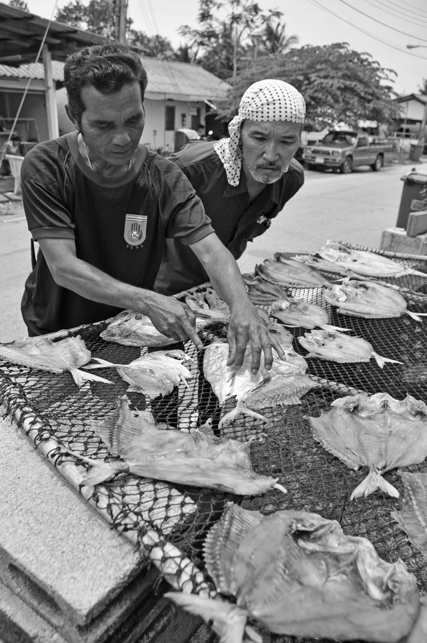
Out of 2,800 houses newly constructed with the aid in the disaster area, 1,800 houses are concentrated in the Namkem Village. There was a population of approximately 4,000 before the tsunami in the village, but after the tsunami it decreased by half. Seven years after the tsunami it has recovered to 3,600, that is 90% of the population before the tsunami. Mr. Prathan (50) lives in subsidized housing with his wife and his youngest son. He makes a living as a merchant of confectionery just like he did before the tsunami. He said that on that day he was experiencing some aftershocks in the market. He heard the roaring noise like a helicopter. When he looked out to the sea, a black tsunami was sweeping towards him with lumber pieces and broken ships. He held his wife from behind who could not swim and was trying to hold onto him. He swam to a tree holding his wife. He pushed and helped his wife climb the tree in which several people had been already there. Finally both of them were saved. However, his mother was in her house when the tsunami came in. She was washed away and became missing. Later her body was discovered. “Things could not be better without life. Even if you lose your property, you can still recover it as long as you are alive.” Mr. Yano thought that there was something simple, but deep and strong in Mr. Prathan’s words since Mr. Prathan went so close to the line between life and death.
In the middle of the Namkem Village, a medium-sized wooden fishing boat was carried inland by the tsunami and has been left there as a monument. Around the monument, there are some buildings standing next to each other. Those buildings are about four-story high. There are some holes like vents and no windows. Mr. Yano heard birds chirping so loud that he looked hard at the direction. He found that swallows were often getting in and out of the buildings. They say that swallow nest farming became popular in the village after the tsunami. All the chirping sound comes from the speakers to attract more swallows. Swallow nests are prized as an ingredient of the fine Chinese cuisine in the world. Mr. Chamnarn (58), one of the owners of the buildings, he used to have a general store and a pig business before the tsunami. “Tsunami is coming! Let’s get out of here.” His son rushed in from the beach in horror. His son rushed him to get out of there. They got on a motorcycle without taking anything with them. They drove up to a hill and survived. He lost all of his pigs. His house was completely washed away except the part that was made of just concrete to put a water tank on. “Some of my friends died because they were trying to take out their valuables in their homes. Although I was half in doubt that a tsunami was really coming, I am so glad that I decided to run away with my son as soon as possible.” He has just finished completing the construction of his building for swallow nest farming with his son. They did not ask a contractor to build it. They did it all by themselves.
On that day Mr. Somsak (54), was working at a fish farm. When he saw the tsunami coming towards him, he hopped on a boat close to him and he was saved. He said that financial aid gave him a home, a boat and fishing gear in six months after the disaster. He is having the same kind of life as he used to have. He has spent about 60,000 yen of his own money to finish tiling in the house. Just like Mr. Puratan, Mr. Somsak also said, “Money is definitely not so important. As long as I am alive, that is good.”
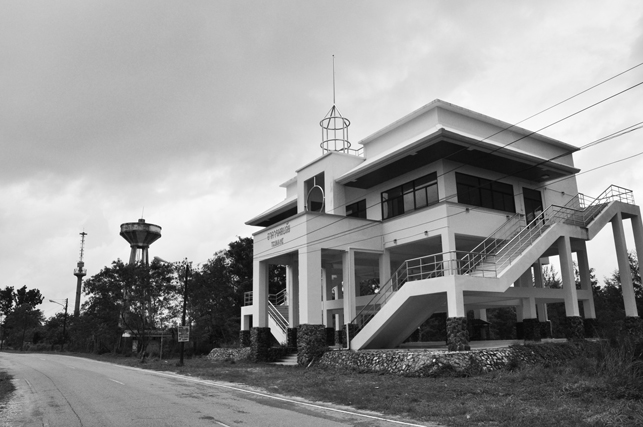
Mr. Somsak was disappointed and said, “If we could have predicted the tsunami, not so many people in the village would have died. At that time people were so curious about the big wave. They did not even think about running away from the spot. Rather they went to see it….” In the village volunteers like Mr. Somsak and Mr. Prathan started a disaster management team and a disaster reduction center. They have given evacuation instructions for the locals. This disaster reduction center is equipped with a radio, a siren and emergency rafts. The shelter location map and the contact list of each organization in emergency communication flow are put up on the wall there. At the time of disaster they can get emergency alerts and some disaster information on broadcast from Bangkok. However, they think, “It would be too late by the time we get to hear from the authority.” Six of three-story evacuation buildings have been under construction alongside the main street about 100 meters from the subsidized housing and alongside the coastal road where resort facilities are standing. On those evacuation buildings it says, “TSUNAMI” in red. Mr. Yano looked it up and said, “They look great.” And then he looked inside. Even if they say those are called three-story buildings, the first and the second floor do not have walls and floors. Only the third floor has rooms. Usually this could be a public hall for the village. But it does not seem like no one is using it. It is not locked so that anyone can go inside and go up on the roof. If you are evacuated here, you will be likely to be saved from tsunamis even over 10 meters high.
The Namkem Village has been located near the seaside. They did not move the village inland even after the tsunami. Mr. Prathan, Mr. Chamnarn and Mr. Somsak all said that they did not think of moving out at all. As they said with one voice, “As long as I am alive, I’ll be OK,” people started to realize that they have to go to higher places without taking anything with them when tsunamis come. This has become one idea on disaster measures and those buildings show the idea.
Ocean View Rooms are Still Popular
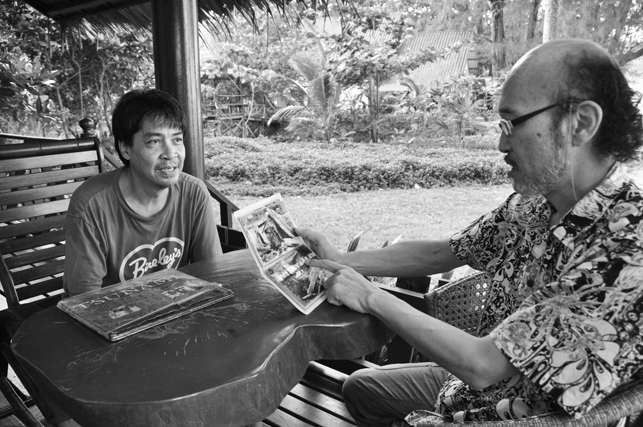
Mr. Manop (56) owns a rubber plantation and he is also a tour guide/driver. He said, “After the tsunami the number of the tourists considerably decreased. Most of the visitors were volunteers. However, tourists have started to come back little by little since two or three years after the tsunami and the city has recovered 60 to 70% of the customers they had before the tsunami.” Mr. Manopu took Mr. Yano to Khao Lak Beach, a revived typical resort in his car and showed himround. On their way to the beach Mr. Yano saw a coast guard patrol boat that was washed ashore and has been left there as a monument. He also noticed there were a private “Tsunami Museum” and some hotels under construction.
It was the next day after Christmas. Guests were having a good time until late at night. The next morning in their cottage most of them were still sleeping. This made the situation worse. 95%, most of the guests and hotel workers became the victims of the tsunami. Mr. Somchart (53), the general manager of Khao Lak Green Beach Resort restored this resort facility which once turned into debris in the third year after he started to rebuild the hotel. He shows some pictures of the area right after the disaster and vigorously talks to Mr. Yano. “In my opinion even if you become the victim of any disaster, we should not stay disappointed for too long. This time since we had to start all over again, we needed to get down to reconstruction quickly. If you start sooner, you can regain your business sooner.”
Mr. Somchart built some cottages on the beach about 10 meters away from the water when it is high tide. Even though accommodation charges are higher as you get closer to the ocean, people make reservations for ocean view rooms. On the other hand, there is no protective structure such as a seawall in the area. This area was attacked by the forces of nature that almost changed the terrain once in several centuries. But this has ever been the beach of everlasting summer free from unpolished man-made objects. Mr. Somchart said that Regular guests loved it and they were the first ones to come back here. According to Mr. Chantrapatong (32), President of the Phang Nga Tourism Association, the number of the hotel rooms was about 7,000 before the tsunami. It has recovered to about 4,000 rooms by the end of last year. The goal by the end of this year is 5,500 rooms. The number of the tourists to the area before the tsunami was 700,000 a year. It has recovered up to 400,000 so far.
And Japan, and Thailand again
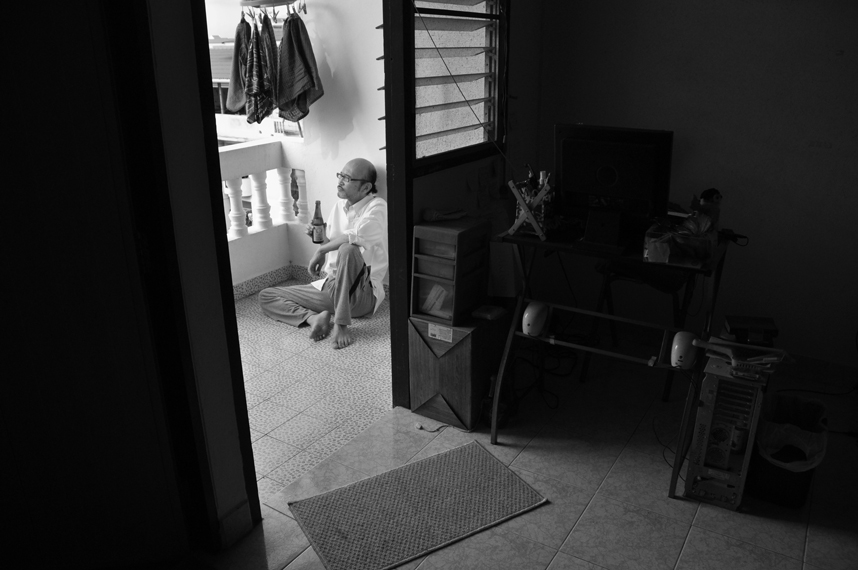
Mr. Yano goes back to Japan every year. The homecoming this time was the one he had to think over what he learnded at the disaster area in southern Thailand. One of the reasons that he goes back to Japan is to meet with volunteer organization staff. Back in his hometown in Kumamoto prefecture, just like Mr. Yano, Mr. Eisho Kawahara (59), the chief abbot of the Rengein Tanjyoji Temple was concerned about the situation of the Indo-Chinese refugees thirty years ago and started an organization called the Renge International Volunteer Association. He has been helping and supporting efforts to provide assistance mainly in Southeast Asia. Mr. Yano reported to Mr. Kawahara. “It has been six years since the disaster. Southern Thailand has been quite revitalized. I thought it was because many residents decided not to leave the area and had been working hard.”
Mr. Yano and Mr. Kawahara, both of them have known each other for a long time. When they talk to each other, they always end up making sure two things: What is needed in revitalization? How should volunteer assistance be? “The most important thing is how much support those volunteers can give continuously to the disaster victims in order to have them stand up on their feet. And the locals get united and recreate a community. If this happens, you can leave them alone.” Mr. Yano and Mr. Kawahara agree with the opinion that the best support for the disaster victims has to be provided in order to have them stand up by themselves.
Mr. Kawahara sees Mr. Yano like this as his volunteer companion. “Mr. Yano went to South East Asia because he couldn’t leave the situation. Even though he makes so many sacrifices, he does not feel that he is making a sacrifice. That’s why Mr. Yano is great. People usually cannot even think of helping others so far away. And if anything happens again, people forget the one that happened before. They forget because they do not get involved in the situation seriously. His attitude towards his volunteer work is like the one toward the woman he loved from the bottom of his heart. It is just like you would never forget the woman even though you got rejected.” Mr. Kawahara is a monk but he dares to describe how strong Mr. Yano’s motivation is by using the passion of love for women as a metaphor.
Mr. Yano started his volunteer work at the refugee camp in Cambodia. He settled in Thailand and has been providing volunteer activities. Of course, there was the reason he became serious about volunteer work. He always climbs Mt. Kokuzousan every time he returns to his hometown. On the mountain he began to talk about his old story looking over the city. “You can see two lifting cranes over there, can’t you?” I saw the Hitachi Zosen Corporation on his fingertip. He had a high school sweetheart who moved from Osaka with her father. Her father was transferred to that Hitachi Zosen Corporation and she was also transferred to his high school. “Since she went to a university in Kyoto, I also went to Kyoto after I spent a year preparing for the entrance examination. But she left me.” He confessed that he wanted to do something he had never done before in a completely different environment to get over the heartbreak. So he decided to aim at providing volunteer activities at refugee camps. Things that really trigger you to do something great must be a very personal experience like this rather than some political reasons.
Vacant houses stood out. In this empty town you often do not see anybody in your view. The population of this town has continued to decline due to the closure of the coal mine. He cannot hide his shocks and loneliness over his deserted home town, Arao. His parents started a rental book shop in their house and it has been in operation till today. Yet, the business has been rare in Japan these days. “As long as I have energy…,” Toshiko, his 87-year-old mother is managing the shop. His late father was a welder in the coral mine as you can expect.
Not only when the place was bustling because of the festivals, but also when there was nothing going on, he used to play almost regularly around the Yotsuyama Shrine located on Mt. Kokuzousan. Under the camphor tree in the shrine compound he looked back the days he spent in southern Thailand. “In the year of the tsunami a lot of big stars, politicians and some higher-ups from big companies came. But now nobody comes to visit the area. I visited them when nobody came. That’s why the Assistant Principal said that she was happy when she saw me. The tsunami left very deep wounds on the survivors. It would be probably the same way for people in Tohoku. I think the survivors were so happy to see me just because they found that somebody still visited the area even though five or six years had passed after the tsunami.
Mr. Yano has been living in Bangkok and this is his 29th year there. Even though Thailand has become his second hometown, it seems that there are some things he can see just because he is a foreigner who has his own home country. “As for revitalization, the local people definitely need to take a great part in it. People in the Namukemu Village have been living with the ocean. They have been making the best use of nature such as the jungle and the beach. Without any locals, the power of the village will immediately fall down to zero or minus. Revitalization from this minus situation, of course, needs people, that is the local people.” The main reason that Arao, his hometown keeps declining is the population decrease.
This time it was only about ten days when he stayed in his hometown. Mr. Yano went back to his apartment in Bangkok. He said that although in Thailand its infrastructure and administrative services are not as developed as they are in Japan, there is something instead that Japan does not have. “All the things they could do was to simply build their own lives again. Nothing else. No embankment has been built. Low places still remain low. It looks like people in Thailand have the attitude that they absolutely never fight against nature. It looks like people in Thailand have given up their fight against nature, anyway. It makes me think that they may be actually strong.”
Mr. Yano’s life is rather simple even for the Thai people. He wakes up and goes to bed in his apartment. His monthly rent is about 6,000 yen. He spends less than 100 yen for a meal in cheep restaurants nearby. “I’m not sure how I can put it into words, but I think I feel comfortable in the Thai society where the people are easygoing and the foreigners here are not discriminated against.” Mr. Yano is easygoing and has fit right in downtown Bangkok. Japanese people tend to get their feelings of happiness by being surrounded with luxurious goods, or preparing for disasters and emergencies, or making sure they get enough social security when they become old. Unlike Japanese it looks like he has learned the Thai-style feelings of happiness. At the end of the day he watches the sunset from the balcony of his apartment with a Thai shochu in his hand. “Well, I feel that the way Thai people think about their fate is very different from the way Japanese people think about their fate. I wonder which is better.” I’m sure that Mr. Yano is thinking that since people can make a trip within a day between Thailand and Japan today, Thai people and Japanese people might be able to share each other’s values beyond time and space.
